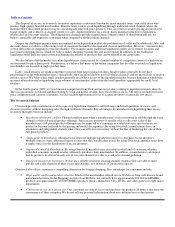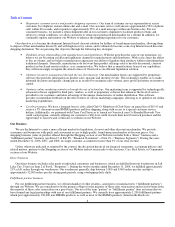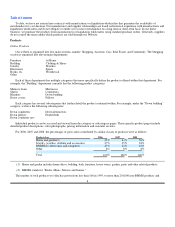Overstock.com 2008 Annual Report Download - page 17
Download and view the complete annual report
Please find page 17 of the 2008 Overstock.com annual report below. You can navigate through the pages in the report by either clicking on the pages listed below, or by using the keyword search tool below to find specific information within the annual report.
Table of Contents
We have a history of significant losses. If we do not achieve and maintain profitability, our financial condition and our stock
price could suffer.
We have a history of losses and we may continue to incur operating and net losses for the foreseeable future. We incurred net
losses of $48.0 million and $12.7 million for the years ended December 31, 2007 and 2008. As of December 31, 2008, our
accumulated deficit was $265.0 million. We will need to generate significant revenues to achieve profitability, and we may not be able
to do so. Even if we do achieve profitability, we may not be able to sustain or increase profitability on a quarterly or annual basis in
the future. If our revenues grow more slowly than we anticipate, or if our operating expenses exceed our expectations, our financial
results would be harmed.
We will continue to incur significant operating expenses and capital expenditures to:
• enhance our distribution and order fulfillment capabilities;
• further improve our order processing systems and capabilities;
• develop enhanced technologies and features;
• expand our customer service capabilities to better serve our customers' needs;
• expand or modify our product offerings;
• occupy warehouse and office space;
• increase our general and administrative functions to support our operations; and
• maintain or increase our sales, branding and marketing activities, including maintaining existing or entering into new
online marketing or marketing analytics arrangements, and continuing or increasing our national television and radio
advertising and direct mail campaigns.
Because we will incur many of these expenses before we receive any revenues from our efforts, our losses may be greater than the
losses we would incur if we developed our business more slowly. Further, we base our expenses in large part on our operating plans
and future revenue projections. Many of our expenses are fixed in the short term, and we may not be able to quickly reduce spending
if our revenues are lower than we project. Therefore, any significant shortfall in revenues would likely harm our business, prospects,
operating results and financial condition. In addition, we may find that these efforts are more expensive than we currently anticipate
which would further increase our losses. Also, the timing of these expenses may contribute to fluctuations in our quarterly operating
results.
If we fail to accurately forecast our expenses and revenues, our business, operating results and financial condition may suffer
and the price of our securities may decline.
Our limited operating history and the rapidly evolving nature of our industry make forecasting operating results difficult. Since
2005, we have completed several large, complex and expensive infrastructure upgrades in order to increase our ability to handle larger
volumes of sales and to develop or increase our ability to perform a variety of analytical procedures relating to our business, and we
are continuing the work to upgrade and further expand these and other components of our infrastructure. We have experienced
difficulties with the implementation of various aspects to the upgrades of our infrastructure, and have incurred increased expenses as a
result of these difficulties. As a result of these expenditures, our ability to quickly reduce spending if our revenues are lower than we
project is limited. Therefore, any significant shortfall in the revenues for which we have built and are continuing to build our
infrastructure would likely harm our business, prospects, operating results and financial condition and cause our results of operation to
fall below the expectations of public market analysts and investors.
The seasonality of our business places increased strain on our operations.
We expect a disproportionate amount of our sales to occur during our fourth quarter. If we do not stock or restock popular
products in sufficient amounts such that we fail to meet customer demand, it could significantly affect our revenue and our future
growth. If we liquidate products, we may be required to take significant inventory markdowns or write-offs, which could reduce gross
profits. We may experience an increase in our net shipping cost due to complimentary upgrades, split-shipments, and additional long-
zone shipments necessary to ensure timely delivery for the holiday season. If too many customers access our Website within a short
period of time due to increased holiday demand, we may experience system interruptions that make our Website unavailable or
prevent us from efficiently fulfilling orders, which may reduce the volume of goods we sell and the attractiveness of our products and
services. In addition, we may be unable to adequately staff our fulfillment and customer service centers during these peak periods and
delivery and other fulfillment companies and customer service co-sourcers may be unable to meet the seasonal demand.
15
























